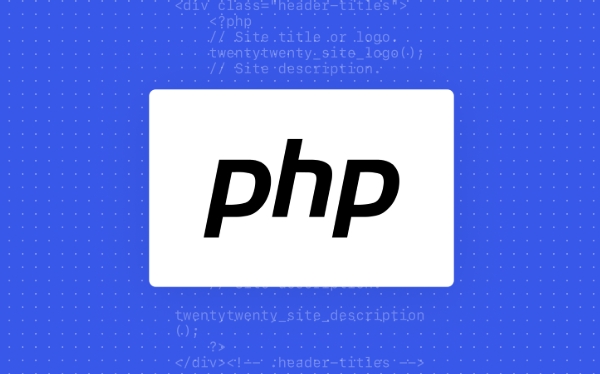 Backend Development
Backend Development
 PHP Tutorial
PHP Tutorial
 The Unsung Hero: Enhancing Code Clarity with PHP Multiline Blocks
The Unsung Hero: Enhancing Code Clarity with PHP Multiline Blocks
The Unsung Hero: Enhancing Code Clarity with PHP Multiline Blocks
Jul 25, 2025 pm 02:29 PMPHP's Heredoc and Nowdoc are effective tools to improve code readability and maintainability. 1. Heredoc supports variable interpolation, suitable for dynamic content such as HTML or JSON; 2. Nowdoc does not parse variables, suitable for plain text output; 3. Both avoid the confusion of quotation escapes and string splicing, making multi-line strings clearer; 4. When using it, make sure that the end identifier occupies one line and has no front and back spaces; 5. Direct insertion of untrusted data should be avoided to prevent security risks; 6. Code readability can be enhanced through unified naming separators (such as HTML, SQL). Reasonable use can significantly reduce cognitive load and improve development efficiency.

PHP multiline blocks are one of those quiet, underappreciated features that, when used well, can dramatically improve code readingability and maintainability—especially in complex applications. While they might not grab headlines like new frameworks or language features, their impact on code clarity is real and often overlooked.

Improving Readability with Heredoc and Nowdoc
Two of PHP's most powerful tools for multiline strings are Heredoc and Nowdoc . These syntaxes allow developers to define strings across multiple lines without the clutter of escaping quotes or concatenating chunks.
- Heredoc behaves like a double-quoted string, supporting variable interpolation.
- Nowdoc acts like a single-quoted string, treating content literally.
This distinction is cruel when embedding HTML, SQL, or configuration snippets directly in code.

$name = "Alice";
$html = <<<HTML
<div class="user-profile">
<h1>Welcome, $name!</h1>
<p>Your account is active.</p>
</div>
HTML;
echo $html;Compare this to the alternative:
echo "<div class=\"user-profile\">\n"; echo " <h1>Welcome, $name!</h1>\n"; echo " <p>Your account is active.</p>\n"; echo "</div>\n";
The Heredoc version is cleaner, easier to read, and less error-prone. It preserves formatting and reduces visual noise—especially helpful when dealing with templates or dynamic content.

Reducing Cognitive Load in Configuration and Templates
When setting up configuration arrays or generating dynamic content like emails or JSON structures, multiline blocks help keep context intact.
For example, defining a complex JSON response:
$response = <<<JSON
{
"status": "success",
"data": {
"user": "$name",
"role": "admin",
"permissions": ["read", "write", "delete"]
}
}
JSON;
echo json_decode($response, true);Without Heredoc, this becomes a tangled mess of escaped quotes and concatenation. With it, the structure remains intuitive and closely mirrors the intended output.
Even in cases where you're building SQL queries (though prepared statements are preferred), Heredoc can help during debugging or logging:
$query = <<<SQL SELECT u.id, u.name, r.role_name FROM users u JOIN roles r ON u.role_id = r.id WHERE u.active = 1 ORDER BY u.name ASC; SQL;
It's instantly clear what the query does—no need to mentally reconstruct line-by-line.
Best Practices and Pitfalls
While powerful, multiline blocks come with quirks:
- The closing identifier must be on its own line, with no leading or trailing whitespace.
- In Heredoc, variables are interpolated, which can lead to unexpected results if not carefully managed.
- For security, avoid injecting untrusted data directly into multiline strings (especially SQL or HTML).
A small but common mistake:
$html = <<<HTML
<p>Hello, $name!</p>
HTML; // ← Indentation or space before 'HTML' causes a fatal errorFix it by ensuring the closing tag is flush left:
$html = <<<HTML <p>Hello, $name!</p> HTML;
Using consistency naming (like HTML , SQL , JSON ) for delimiters also improves clarity—anyone reading the code immediately understands the content type.
Used thoughtfully, PHP's multiline blocks aren't just syntactic sugar—they're a practical tool for writing clearer, more maintained code. They let developers focus on structure and logic instead of escaping quotes or wrestling with string concatenation. Not flashy, but undeniably useful.
The above is the detailed content of The Unsung Hero: Enhancing Code Clarity with PHP Multiline Blocks. For more information, please follow other related articles on the PHP Chinese website!

Hot AI Tools

Undress AI Tool
Undress images for free

Undresser.AI Undress
AI-powered app for creating realistic nude photos

AI Clothes Remover
Online AI tool for removing clothes from photos.

Clothoff.io
AI clothes remover

Video Face Swap
Swap faces in any video effortlessly with our completely free AI face swap tool!

Hot Article

Hot Tools

Notepad++7.3.1
Easy-to-use and free code editor

SublimeText3 Chinese version
Chinese version, very easy to use

Zend Studio 13.0.1
Powerful PHP integrated development environment

Dreamweaver CS6
Visual web development tools

SublimeText3 Mac version
God-level code editing software (SublimeText3)

Hot Topics
 Multiline vs. Single-Line Comments: A Strategic Guide for PHP Developers
Jul 27, 2025 am 04:33 AM
Multiline vs. Single-Line Comments: A Strategic Guide for PHP Developers
Jul 27, 2025 am 04:33 AM
Single-line comments (//) are suitable for short, local instructions or debugging, 1. Use // for in-line comments or temporarily disable code; 2. Use // for multi-line comments to provide detailed descriptions of complex logic or comment large pieces of code; 3. Use /*/ to write PHPDoc to implement structured documents and integrate with the IDE; 4. Avoid comments to be obvious code; 5. Always keep comments updated to ensure comments clearly convey intentions rather than just describe operations, thereby improving code maintainability.
 How Modern IDEs Transform PHP Comments into Navigational Tools
Jul 25, 2025 am 04:43 AM
How Modern IDEs Transform PHP Comments into Navigational Tools
Jul 25, 2025 am 04:43 AM
PHPDoccommentsprovidetypehints,enableautocomplete,detecterrors,andsupportnavigationinIDEsbyactingasstructuredmetadata.2.Specialinlinecommentslike//TODOor//FIXMEareparsedintoactionabletasks,allowingdeveloperstonavigate,filter,andtrackworkdirectlyfromt
 The Perils of Nested Multiline Comments in PHP
Jul 26, 2025 am 09:53 AM
The Perils of Nested Multiline Comments in PHP
Jul 26, 2025 am 09:53 AM
PHPdoesnotsupportnestedmultilinecomments,andattemptingtonestthemcancauseunexpectedcodeexecutionorparseerrors;thefirst/closestheentirecommentblock,soanycodefollowingit—evenifintendedtobecommented—willbeexecuted,leadingtobugsorfatalerrorswhenfunctionsa
 Writing Clean File Headers: A Standardized Approach with Multiline Comments
Jul 25, 2025 am 11:13 AM
Writing Clean File Headers: A Standardized Approach with Multiline Comments
Jul 25, 2025 am 11:13 AM
Awell-structuredfileheaderimprovescodereadabilityandcollaborationbyprovidingkeyfileinformationupfront.1.Includethefile’spurpose,author,creationandmodificationdates,version,license,dependencies,andoptionalnotes.2.Useaconsistentmultilinecommentformatli
 Mastering the Nuances of PHP Block Commenting
Jul 26, 2025 am 09:42 AM
Mastering the Nuances of PHP Block Commenting
Jul 26, 2025 am 09:42 AM
PHPblockcommentingisessentialfordocumentinglogic,disablingcode,andcreatingstructureddocblocks;1.Use//formulti-linecommentsbutavoidnesting,asitcausesparseerrors;2.Youcansafelyinclude//commentsinside//blocks;3.Alwayscloseblockcommentswith/topreventunin
 Leveraging PHPDoc Blocks for Superior Code Maintainability
Jul 24, 2025 pm 10:25 PM
Leveraging PHPDoc Blocks for Superior Code Maintainability
Jul 24, 2025 pm 10:25 PM
PHPDocsignificantlyenhancesPHPcodemaintainabilityandclarity.1.Itprovidestypeclarityevenwithoutstricttyping,documentingparameters,returnvalues,andpropertieswithprecision.2.Itdescribescomplexreturntypeslikestructuredarrays,nullablevalues,anduniontypes,
 The Unsung Hero: Enhancing Code Clarity with PHP Multiline Blocks
Jul 25, 2025 pm 02:29 PM
The Unsung Hero: Enhancing Code Clarity with PHP Multiline Blocks
Jul 25, 2025 pm 02:29 PM
PHP's Heredoc and Nowdoc are effective tools to improve code readability and maintainability. 1. Heredoc supports variable interpolation, suitable for dynamic content such as HTML or JSON; 2. Nowdoc does not parse variables, suitable for plain text output; 3. Both avoid the confusion of quotation escapes and string splicing, making multi-line strings clearer; 4. When using it, make sure that the end identifier occupies one line and has no front and back spaces; 5. Direct insertion of untrusted data should be avoided to prevent security risks; 6. Code readability can be enhanced through unified naming separators (such as HTML, SQL). Reasonable use can significantly reduce cognitive load and improve development efficiency.
 From Comments to Contracts: The Power of PHPDoc Annotations
Jul 25, 2025 am 04:41 AM
From Comments to Contracts: The Power of PHPDoc Annotations
Jul 25, 2025 am 04:41 AM
PHPDoccommentsarenotjustfordocumentation—theyserveasstructuredmetadatathatenhancecodereliabilityandmaintainability.1)TheyprovidetypehintsbeyondPHP’snativesyntax,allowingprecisedefinitionslikearrayornullabletypes,whichtoolslikePHPStanuseforstaticanaly





